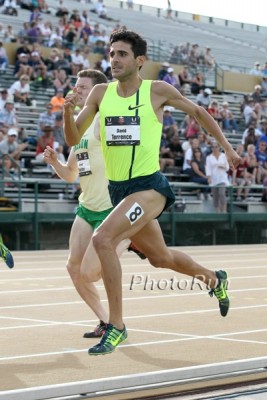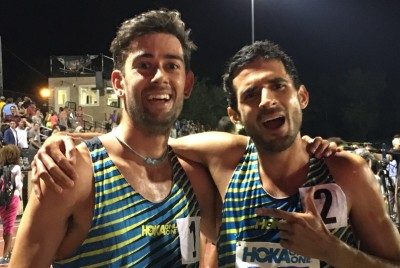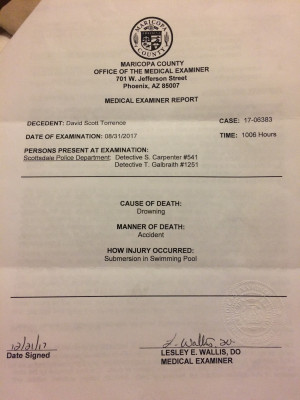David Torrence’s Death Ruled an Accidental Drowning, But For His Family Questions Remain Because Of Death Threats
Torrence Allegedly Received Death Threats on Facebook During the Summer of 2016 But Police Claim Probable Cause Does Not Exist for a Search Warrant for Torrence’s Facebook Account
By Jonathan Gault
February 12, 2018
The Scottsdale Police Department announced last week, almost six months after the body of Peruvian-American Olympic runner David Torrence’s was found in a swimming pool at his condominium complex on the morning of August 28, 2017, that the investigation into his death is complete with the death being ruled accidental.
“The investigation of this incident by the Scottsdale Police Department has been completed. Mr. Torrence’s death, although tragic, has been ruled accidental. There is no evidence that indicates a criminal nexus or foul play in this incident,” wrote Scottsdale PD spokesman Kevin Watts in an email to LetsRun.com.
That conclusion is in line with the conclusion of Maricopa (Arizona) County Medical Examiner Lesley Wallis, who conducted the autopsy on Torrence. After examining Torrence’s body, Wallis concluded, “Based on the autopsy findings and investigative history as available to me, it is my opinion that David Scott Torrence, a 31-year-old male, died as a result of Drowning. The manner of death is Accident.”
However, given the fact that Torrence was known to be a strong swimmer, the natural question is what could have caused Torrence to drown.
While the medical examiner’s report ruled Torrence’s death an accidental drowning, David’s mother, Bianca Torrence, is frustrated because she feels investigators didn’t seriously consider another possible cause of death: murder. Bianca said that multiple people told her that David had received death threats on Facebook during the summer of 2016 and said she does not believe that Scottsdale PD has taken the information about the death threats seriously.
“They didn’t seem to pay attention to it,” Bianca said. “It bothers me that they haven’t looked into the death threats. They’re saying it’s just rumors. What [Toni Galbraith, the detective working the case] said is David didn’t take the threat seriously. Talking to his friends about the death threats, David didn’t take them seriously. And I was like, what does that matter?”
What was in the medical examiner’s and toxicology reports?
Torrence’s toxicology report was positive only for a low level of alcohol; a single half-empty can of beer was found in Torrence’s apartment at Center Court Condominiums in Scottsdale, which he was renting from a cousin. Wallis’ report also noted that: “microscopic examination revealed slight smooth muscle hypertrophy of the epicardial vessels with suggestion of intramyocardial perivascular fibrosis. These cardiac changes suggest possible hypertensive cardiovascular disease which can lead to sudden cardiac arrythmias.” In addition, Wallis noted that “the mid portion of the left anterior descending coronary artery extends within the underlying myocardium to a depth of approximately 0.4 cm and for a length of approximately 0.7 cm.” This is a defect known as a myocardial bridge.
LetsRun.com shared the medical examiner’s report with several physicians to get their take on what the above medical jargon means. While none could offer a definitive ruling based on the information included in the report, they did provide some valuable insight and explained that a heart irregularity could have resulted in Torrence drowning.
“I would be very suspicious that this was not a primary drowning event and that a cardiac problem is a more likely explanation,” wrote Dr. Andre La Gerche, head of Sports Cardiology and Cardiac Magnetic Resonance Imaging at the Baker Heart and Diabetes Institute in Melbourne. “The most common cause of a fatal sudden cardiac event in a 31-year-old is an electrical problem (the heart going into a fast uncoordinated cardiac rhythm that causes the heart to have very limited output). In about one-third of cases like this, we do not find a cause for why the heart went into a sudden arrhythmia.
“There are some hints on [Torrence’s] autopsy but it is hard to know whether they were the cause of [a potential] sudden arrhythmia. The ‘tunnelled LAD (Left Anterior Descending artery)’ refers to part of one of the main heart arteries travelling through the heart muscle rather than on its surface. We see this sometimes and it is very unclear exactly how common this is and whether it causes sudden death. I do not really know what to make of this.
“The other ‘abnormality’ on the autopsy is a small amount of fibrosis or scar in the heart muscle. Again, whether this is abnormal depends on the quantity and its appearance. It is a bit subjective and the reporting pathologist does not seem to make much of this. We do see fibrosis in some athletes and there is some controversial argument to suggest that it may occur more commonly in athletes and that it may occasionally cause sudden death. I mention that for completeness and would not leap to that conclusion here.”
Dr. Benjamin Levine is the Harry S. Moss Heart Chair for Cardiovascular Research as well as the director of the of Institute for Exercise and Environmental Medicine at Texas Health Presbyterian Dallas.
“All of us think ‘long QT syndrome‘ when a young person (and a strong swimmer at that) appears to have drowned – that is the inherited electrical disorder that Andre is talking about,” Levine wrote. “I agree with Andre, especially about avoiding making armchair diagnoses in patients/athletes we have not seen. I was impressed that the pathologist seemed to be hedging on the fibrosis bit. [She] never actually seemed confident that [she] saw it, and I would want to talk to the pathologist further and see what [she] really meant. I think the tunneled LAD is a red herring.”
(Editor’s note: Fibrosis is the thickening and scarring of connective tissue.)
The general consensus is that no one knows for sure what happened to David Torrence.
“I am a very big advocate of leaving the question unanswered rather than providing a speculative cause,” wrote La Gerche. “I would regard the ‘drowning’ cause as highly speculative. Important alternate diagnoses may be missed when a cause for death is provided in the context of considerable uncertainty.”
Frustration for a grieving mother
The uncertainty regarding Torrence’s death has been the cause of endless frustration for Bianca over the past five months.
Bianca said she understands that some people may have assumed David Torrence died of a tragic hereditary health problem. It was reported by the San Jose Mercury News that Torrence’s father, Scott, died of a brain aneurysm at age 31 in 1992 and, like his father, David was 31 years old when he died. However, Bianca told LetsRun that the cause of death mentioned in the Mercury News’ story was incorrect; thus there was no abnormal condition to inherit.
Bianca Torrence said she and her daughter, Sylvie, have been frustrated by how the Scottsdale Police Department handled its investigation. The Torrences claim that once David’s body was found, the surrounding area was never quarantined with police tape; a neighbor whose apartment overlooks the pool also told LetsRun.com that this was the case. Though detectives at the time claimed that there were no obvious signs of foul play, multiple Scottsdale PD officers noted in their official report that the entry gates to the pool were taped off.
Bianca was also frustrated about how long Scottsdale PD’s investigation was taking. The toxicology report was signed and dated as being completed on October 19; the medical examiner’s report was signed and dated on December 21. Yet when Bianca Torrence spoke with Toni Galbraith, the detective on Torrence’s case, on January 30, Galbraith told her that she was still waiting on results of the autopsy (medical examiner’s report and toxicology report). In her investigation report, Galbraith said she did not receive the autopsy results until February 6. Yet, following a public records request made last fall, LetsRun received a copy of the medical examiner’s report and Torrence’s toxicology report on January 12.
As for the death threats, Anna Fuka, a former girlfriend who stayed with Torrence at his apartment on the night of August 26, told Scottsdale PD that Torrence had received death threats during the summer of 2016. Two more sources told LetsRun.com that Torrence also told them about receiving death threats that summer.
Alex, a close friend of David’s, informed Bianca that David had received a death threat on Facebook (Alex is an alias; the source requested that their name be changed to protect their identity). Bianca said she has heard the same thing from two other people. Alex did not read the death threat personally but said that Torrence read the message to Alex over Skype.
“David had called me and he told me that he received these crazy death threats,” Alex said. “He read them to me over Skype, it was over Skype. And I was just like, I don’t really know what to make of this. I don’t know if these people are serious, but David, I think you need to take this seriously.”
Steve Magness, who served as a whistleblower during the BBC/ProPublica investigation into the Nike Oregon Project in 2015, said that Torrence also told him about the death threat on Facebook though, like Alex, he did not see the actual message.
“I remember specifically him telling me about he’d gotten some online threats,” Magness said. “I can’t recall who from…He didn’t know how to take them, right? At the time, I think both of us are like, Oh yeah, people just kind of say that stuff, right? And you never know. I got strange threats as well when my own whistleblowing stuff came out. You give it a moment to think about it, but you hope people are rational. And you think that we live in a rational modern society and it’s just track and field, so hopefully everything’s all right. That’s how I interpreted he took it at the time.”
Alex told LetsRun that David received the threats shortly after it was revealed that Torrence had served as an informant in the IAAF’s investigation into coach Jama Aden. Torrence trained under Aden in 2014. Aden was arrested by Spanish police in a raid of a hotel in Sabadell, Spain, in June 2016, where police found doping materials, including EPO. Aden denied providing performance-enhancing drugs to his athletes. Spanish authorities have yet to announce any charges against Aden, nor has the IAAF issued a public sanction against him. Aden has been out of the spotlight since he was spotted at the Doha Diamond League meet in May 2017.
According to the Scottsdale PD’s investigation report, in an interview with Detective Carpenter, John Cook, Torrence’s former coach, said that after Torrence left Aden’s training group, Cook “received an email from someone related to the Aden organization which stated they were not done with David however he no longer had it in his possession…Later in the conversation John said that Jama emailed him directly and threatened to get David one way or the other for running him [sic] mouth. John said he tried to calm things down and after that Jama stopped communicating with him.”
Cook, who briefly coached Aden as an athlete during the 1980s, told LetsRun.com that while he did talk to the police, he denied making the statements above and that he has had no contact with Aden since the 2012 Olympics. He said he did not receive an email from anyone related to the Aden organization after Torrence left the training group.
(Editor’s note: While Cook denied receiving threats related to Torrence, he did tell LetsRun.com that he personally received threats after he raised doubts about the performance of one of Aden’s athletes, Taoufik Mahkloufi of Algeria, after Makhloufi won gold in the 1500 meters at the 2012 Olympics. However, Cook said that none of the threats came from Aden.
“I received a lot of threats from the government of Algeria and also from some officials and I backed off immediately,” Cook said. “I just didn’t need that.”
Thus, it is possible that there was a miscommunication and these are the threats Detective Carpenter referenced.)
Paul Koros, the cousin from whom David was renting his apartment in Scottsdale, was interviewed on December 20 by Detective Galbraith. He told Galbraith that the death threats had been made on Facebook. Galbraith told him that was the first time she had heard that the threats were made on Facebook; Bianca Torrence claims that she told Galbraith that specific piece of information in September.
“They were repeatedly told [the threats] were [in] the Facebook messages,” Bianca Torrence said. “That’s why we need access to his account, because we don’t have his messages.”
Bianca Torrence has tried on her own, so far unsuccessfully, to gain access to her son’s Facebook account. In order to request content from the account of a deceased person, Facebook requires “proof that you’re an authorized representative (example: family member) and a court order.” Bianca has tried to access David’s account and says that she has submitted documents, including David’s death certificate and proof of her identity, to Facebook, but has so far been unable to access David’s account to view the message.
Galbraith wrote in her investigation report that she searched Torrence’s Facebook page and did not find any threats on posts made for public view (this did not include any private messages Torrence received through Facebook). The police can also access the account by obtaining a search warrant of the Facebook account, but the Scottsdale PD declined to pursue one, with Detective Galbraith noting in her investigation report that probable cause did not exist.
“Because David didn’t take [the threats] seriously, then there was no probable cause?” Bianca said. “If David took this seriously, maybe this wouldn’t have happened…I just think the investigation was very shoddy and from the beginning, they just wanted to close the case…They were just waiting for toxicology and were going to close the case.”
On February 6, after reviewing the medical examiner’s report and toxicology report and stating that there were no further leads to investigate, Scottsdale Police closed the case. Scottsdale PD declined interview requests from LetsRun.com.
|
How long was Torrence dead for before his body was found? According to the Scottsdale Police Department’s investigation report, Torrence’s body was found face-down at the bottom of the pool at Center Court Condominiums in Scottsdale, Arizona, where he was renting an apartment from his cousin. Torrence was found wearing swimming trunks. A Center Court resident who went out to walk her dog at 6:30 a.m. on August 28 was the first to find Torrence’s body, though it is possible his body had been there for some time (neither the investigation report nor the medical examiner’s report made an estimate of how long Torrence had been dead for before his body was found). The resident told a maintenance man who called 911 around shortly before 7:16 a.m. An ambulance and police officer arrived on scene shortly, and Torrence was declared deceased at 7:21 a.m. Torrence’s iPhone had not been unlocked since 9:05 p.m. on the night of August 27 at the latest as he had received a text message from his coach Ricky Soos at that time which still appeared on the lock screen when the phone was recovered. Dennis Buono worked as supervisor of the maintenance department at Center Court, until he was terminated on August 25, three days before Torrence’s body was found. Though he is no longer employed by Center Court, he continues to live on the premises and said that, out of habit, he was walking around the complex around 12:15 a.m. on August 28 when he noticed one of the gates to the south pool — the one where Torrence’s body was found a few hours later — was unlocked (the pool is supposed to be closed between midnight and 5 a.m.). Buono said he checked again at 1:30 a.m. and the gate was still unlocked. There are three gates to the south pool, and Buono said the one that was unlocked was the one closest to Torrence’s apartment; Buono said he did not check the other two gates. The complex employs a security guard, and Buono said that it is the security guard’s job to lock all three gates at night when the pool is closed. Buono also said that there are two bathrooms by the pool (inside the gates) that are supposed to be locked at night and that if the security guard had locked those gates and there had been a body in the pool, it would have been impossible to miss. Residents do not have a key to the locked gate; only the security guard does. “[Locking the gates] is [the security guard’s] job, and I feel he failed,” Buono said. Buono, who had worked at Center Court for just over two years, said he did not know why he was terminated from his position. “I have no idea,” Buono said. |
Talk about this article on the LetsRun.com messageboard. MB: David Torrence’s Death Ruled an Accidental Drowning, But For His Family Questions Remain Because Of Death Threats.



